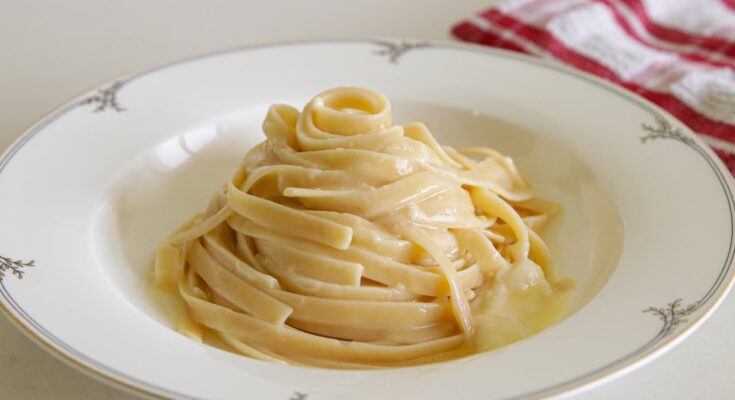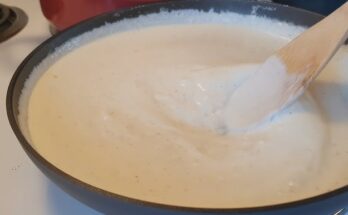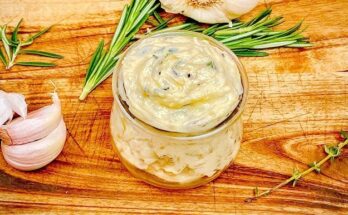Authentic Alfredo Sauce Recipe: If you’re craving something rich, creamy, and oh-so-satisfying, an authentic Alfredo sauce is exactly what you need. This classic sauce—silky, cheesy, and comforting—is more than just something you pour over fettuccine. It’s a heartwarming culinary experience you can easily recreate in your kitchen. And the best part? It takes less than 30 minutes from start to finish.
In this detailed guide, you’ll not only find a foolproof recipe but also every tip and trick to make the creamiest, dreamiest Alfredo sauce imaginable. Whether you’re a seasoned home cook or a beginner testing your skills, this article has got you covered.
What Is Alfredo Sauce?
Let’s clear the air—Alfredo sauce didn’t start out the way you think. The original “Fettuccine Alfredo” was invented in early 20th-century Rome by a man named Alfredo di Lelio. The recipe was shockingly simple: fresh fettuccine, butter, and aged Parmesan. No cream, no garlic, no heavy seasoning. That’s right—traditional Italian Alfredo is much lighter than the creamy version we’re used to in the U.S.
When the dish crossed over to America, it evolved into something richer and more indulgent. American-style Alfredo includes heavy cream, butter, and a generous amount of cheese. Some versions also incorporate garlic, nutmeg, or even cream cheese. And honestly, while it may not be “authentic” in the strictest sense, it sure is delicious.
So, this guide focuses on the American-style Alfredo sauce we all know and love—with a few chef-level enhancements to bring out the best flavor possible.
Why Make Homemade Alfredo Sauce?
Sure, you could grab a jar of store-bought Alfredo, but let’s be honest—it never quite hits the same. Making Alfredo sauce from scratch offers a world of benefits:
- Flavor Explosion: Fresh ingredients lead to richer, deeper flavors. Jarred sauce often lacks depth and can taste overly processed or salty.
- Total Control: When you make it yourself, you decide how creamy, cheesy, garlicky, or thick it should be.
- No Preservatives: Homemade sauce is free of artificial thickeners, stabilizers, or preservatives commonly found in store-bought versions.
- Impress Factor: Want to wow your guests or your date? A homemade Alfredo sauce will make you look like a kitchen rock star.
Trust me, once you taste the real deal, you’ll never want to go back to the jar.
List of Ingredients You’ll Need
Alright, let’s get to the good stuff—the ingredients. This sauce is simple, but the quality of each component makes a huge difference.
Core Ingredients:
- 1/2 cup (1 stick) unsalted butter – High-fat European-style butter gives you extra richness.
- 1 1/2 cups heavy cream – Go full-fat. This is not the time to diet.
- 2 cups freshly grated Parmesan cheese – Freshly grated is non-negotiable. Pre-shredded cheese won’t melt smoothly.
- 2–3 garlic cloves (minced, optional) – Adds a savory punch without overpowering the sauce.
- Salt (to taste) – Use kosher or sea salt for best results.
- Freshly ground black pepper (to taste) – Adds a nice contrast to the creamy flavor.
- Nutmeg (a pinch, optional) – A traditional Italian touch that enhances the creaminess.
Optional Add-Ins:
- Cream cheese (2 oz) – For extra creaminess and stability (especially if reheating).
- Parsley (chopped, for garnish) – For freshness and color.
Make sure your ingredients are fresh and at room temperature for the smoothest results. Trust me, your sauce will thank you.
Kitchen Tools You’ll Need
Making Alfredo sauce doesn’t require fancy gadgets, but a few kitchen staples make a big difference.
- Heavy-bottomed saucepan – Prevents burning and helps with even heating.
- Wooden spoon or silicone spatula – For stirring without scratching the pan.
- Whisk – Ensures a smooth, lump-free sauce.
- Measuring cups and spoons – Precision matters here.
- Grater or microplane – For freshly grating that Parmesan.
Pro tip: Avoid nonstick pans if possible—they often don’t retain heat evenly for sauces like this.
Prep Time and Cooking Time
Here’s how much time you’ll need from start to finish:
- Prep Time: 5–10 minutes (mostly grating cheese and mincing garlic)
- Cook Time: 15–20 minutes
- Total Time: 25–30 minutes
That’s it—30 minutes to creamy, cheesy heaven.
Step-by-Step Guide to Making Alfredo Sauce
Let’s break this down so there’s zero room for error. Follow each step carefully and you’ll have a silky-smooth Alfredo sauce worthy of any fine-dining menu.
Step 1: Gather and Measure Ingredients
Before turning on the heat, prep everything. Measure out your butter, cream, cheese, and seasonings. Grate the Parmesan if you haven’t already—seriously, don’t skip this.
Having everything ready to go prevents scrambling at the stove and ensures you don’t overcook anything.
Step 2: Melt the Butter Slowly
Place your saucepan over medium-low heat. Add the butter and let it melt gently. Don’t rush this—high heat can cause the butter to brown or burn, which we don’t want for Alfredo sauce.
Stir occasionally until fully melted and foamy.
Step 3: Add Garlic (Optional but Recommended)
If using garlic, toss it in now. Sauté it in the butter for about 30 seconds to 1 minute—just until fragrant. Don’t let it brown; burnt garlic will ruin the flavor.
This step adds a beautiful aromatic base that enhances the richness of the sauce.
Step 4: Pour in the Heavy Cream
Slowly pour the cream into the pan with the melted butter. Stir continuously as you pour to help everything combine smoothly.
Let the mixture come to a gentle simmer. Don’t let it boil—this can cause the fat to separate, leading to a broken sauce.
Let it simmer for 5–7 minutes, stirring often.
Step 5: Simmer Until Slightly Thickened
As the cream and butter mixture heats, it’ll start to thicken. You’re looking for a texture that coats the back of a spoon—not too thick, not too watery.
This is where patience pays off. Stir gently and often to prevent scorching.
Step 6: Stir in the Parmesan Cheese
Now comes the magic moment—the cheese.
Reduce the heat to low and slowly begin adding the freshly grated Parmesan, one handful at a time. Stir constantly to help it melt and integrate smoothly into the cream and butter mixture. Rushing this step or using pre-shredded cheese (which contains anti-caking agents) can cause clumping.
Keep stirring until all the cheese is fully melted and the sauce looks smooth and creamy. The consistency should be velvety, not grainy. If it feels too thick, you can add a splash of milk or a bit more cream to loosen it up.
Step 7: Season with Salt and Pepper
Taste your sauce before adding any salt—Parmesan is naturally salty, so you may not need much. Then, sprinkle in some freshly ground black pepper to taste.
Want to elevate the flavor a notch further? Add a pinch of nutmeg. It sounds unusual, but nutmeg subtly enhances the creamy, savory elements in the sauce. It’s a small touch with a big payoff.
Step 8: Simmer Until Creamy and Smooth
Let the sauce gently simmer for another 2–3 minutes on low heat. This allows the flavors to meld and the sauce to reach the perfect consistency.
Give it a few final stirs, making sure there are no lumps and that everything is fully incorporated. If the sauce seems too thick, add a tablespoon of cream or milk. Too thin? Let it simmer a bit longer while stirring—just don’t let it boil.
Step 9: Serve Immediately
Alfredo sauce is best served fresh and hot—right off the stove. Pour it generously over cooked pasta, stir it in, and serve immediately.
For the classic combo, use fettuccine noodles, but feel free to experiment. Garnish with extra Parmesan, a bit of chopped parsley, or even a drizzle of truffle oil if you’re feeling fancy.
Tips for the Perfect Alfredo Sauce
Even though Alfredo sauce is simple, a few pro tips can take your version from good to unforgettable:
- Use Fresh Parmesan Only – Pre-shredded cheese often contains anti-caking additives that prevent it from melting smoothly.
- Low and Slow Is the Motto – Avoid overheating the sauce. Cream and cheese are delicate—they’ll separate if boiled.
- Stir Continuously – This ensures even cooking and prevents clumps or burning at the bottom of the pan.
- Don’t Skip Garlic and Nutmeg – While not part of the original Italian recipe, these two ingredients seriously enhance the flavor.
- Add Cheese Last – Adding cheese too early while the sauce is too hot can cause it to seize and become gritty.
Consistency is key—if your sauce feels too thick, a splash of milk or reserved pasta water can save the day.
Common Mistakes to Avoid
You wouldn’t believe how easy it is to mess up Alfredo sauce. But don’t worry—I’ve got your back. Here are the most common mistakes and how to dodge them:
- Overheating the Sauce: Alfredo is delicate. If you boil it or crank the heat up too high, you’ll end up with an oily mess.
- Using Pre-Shredded Cheese: Seriously, just don’t. It doesn’t melt well and will give you a grainy texture.
- Adding Cheese to Boiling Cream: High heat causes cheese to clump. Always add cheese off the heat or on low.
- Not Stirring Enough: Stir constantly to keep everything smooth and prevent scorching.
- Skipping Seasoning: Salt, pepper, and a pinch of nutmeg elevate the flavor. Bland Alfredo is a tragedy.
What Pasta Pairs Best with Alfredo Sauce?
While fettuccine is the most traditional partner, Alfredo sauce plays well with a variety of pasta shapes.
Top Pasta Picks:
- Fettuccine – The wide, flat shape is perfect for holding creamy sauce.
- Linguine – A slightly thinner alternative to fettuccine.
- Pappardelle – Even wider and more indulgent.
- Rigatoni or Penne – The hollow tubes trap the sauce inside. Yum.
- Tortellini or Ravioli – Especially delicious if they’re stuffed with cheese or spinach.
For the ultimate Alfredo experience, cook your pasta al dente and toss it immediately with the sauce. Don’t rinse the pasta—it removes the starch that helps the sauce stick.
Adding Proteins and Vegetables
Want to turn your Alfredo from a side dish into a full-on meal? Add-ins are the way to go.
Best Protein Additions:
- Grilled Chicken – A classic. Slice it thin and place it on top.
- Shrimp – Sautéed in garlic and butter, shrimp pairs beautifully with the creamy sauce.
- Bacon or Pancetta – Adds a salty, smoky punch.
- Salmon – A richer seafood option that works surprisingly well.
Best Vegetable Additions:
- Broccoli – Steamed and tossed in.
- Mushrooms – Sautéed mushrooms deepen the umami.
- Spinach – Wilts perfectly into the hot sauce.
- Peas – For a pop of sweetness and color.
- Sun-dried Tomatoes – For a tangy, chewy contrast.
Just make sure anything you add is cooked beforehand. Alfredo sauce comes together fast and doesn’t provide enough time to cook proteins or raw veggies from scratch.
How to Store and Reheat Alfredo Sauce
Homemade Alfredo sauce tastes best fresh, but you can store and reheat it if needed.
Storage Tips:
- Let the sauce cool completely.
- Store in an airtight container.
- Refrigerate for up to 3–4 days.
Reheating Tips:
- Reheat slowly over low heat.
- Add a splash of milk or cream to loosen it.
- Stir continuously to prevent the sauce from breaking.
Never microwave Alfredo on high power—it’ll separate and become oily. If you must use a microwave, go low and slow, stirring every 20 seconds.
Can You Freeze Alfredo Sauce?
You can freeze Alfredo sauce, but with a caveat—it may separate when thawed due to the high fat content.
Freezing Tips:
- Use airtight containers or freezer bags.
- Let sauce cool completely before freezing.
- Freeze for up to 1 month.
To Reheat from Frozen:
- Thaw overnight in the fridge.
- Warm slowly in a saucepan with added cream or milk, whisking constantly.
If you plan to freeze a batch, consider adding a little cream cheese to the sauce—it stabilizes the texture and helps prevent separation when reheated.
Alfredo Sauce Variations
Want to switch things up a bit while keeping that rich, creamy Alfredo vibe? There are tons of ways to tweak the classic Alfredo sauce recipe to suit different dietary needs and flavor profiles.
1. Vegan Alfredo Sauce
Yes, it’s possible—and delicious!
- Replace heavy cream with full-fat coconut milk or a blend of almond milk and cashews.
- Use vegan butter or olive oil.
- Swap Parmesan for nutritional yeast or a plant-based cheese alternative.
- Add garlic, onion powder, and lemon juice for flavor depth.
The result is still creamy and satisfying but completely dairy-free.
2. Low-Fat Alfredo Sauce
Trying to keep it light?
- Use half-and-half or even low-fat milk instead of heavy cream.
- Add a bit of flour or cornstarch as a thickening agent.
- Go easy on the butter and cheese (but don’t eliminate them entirely—you still need that Alfredo flavor!).
3. Herbed Alfredo Sauce
Add fresh or dried herbs like:
- Basil
- Oregano
- Thyme
- Parsley
- Chives
Stir them in at the end for a bright, aromatic finish.
4. Spicy Alfredo Sauce
Want to crank up the heat?
- Add red pepper flakes or a dash of Cajun seasoning.
- A swirl of hot sauce or chipotle paste can also give it a smoky, spicy kick.
This spicy twist pairs well with shrimp or chicken over penne.
FAQs about Authentic Alfredo Sauce Recipe
1. Can I make Alfredo sauce ahead of time?
Yes, but it’s best fresh. If you prep it in advance, store it in an airtight container and reheat it gently with a splash of milk or cream to revive the texture.
2. Why is my Alfredo sauce grainy or clumpy?
It’s usually because the cheese was added too quickly or the sauce got too hot. Use fresh grated cheese and keep the heat low when incorporating it.
3. What can I use instead of heavy cream?
Half-and-half, whole milk, evaporated milk, or a dairy-free alternative like cashew cream work well. Just remember, the creamier the base, the richer the sauce.
4. How do I fix a broken Alfredo sauce?
Whisk in a splash of cold cream or milk and keep stirring over low heat. This often helps re-emulsify the sauce.
5. Is Alfredo sauce gluten-free?
Yes, this recipe is naturally gluten-free! Just be cautious about what pasta or thickening agents you use if making variations.
Conclusion
Making authentic Alfredo sauce from scratch isn’t just easy—it’s a total game-changer. With just a few fresh ingredients and a little love, you’ll have a luxurious, creamy, and comforting sauce that beats anything from a jar. Whether you stick to the classic or venture into spicy, vegan, or herbed versions, this recipe is your golden ticket to pasta night perfection.
Remember, the secret to perfect Alfredo sauce isn’t in a packet—it’s in the pan, your hands, and a bit of patience. Trust the process, taste as you go, and don’t skimp on the cheese!
So next time you crave something creamy and soul-warming, ditch the jar and grab a saucepan. Your future self (and your taste buds) will thank you.



